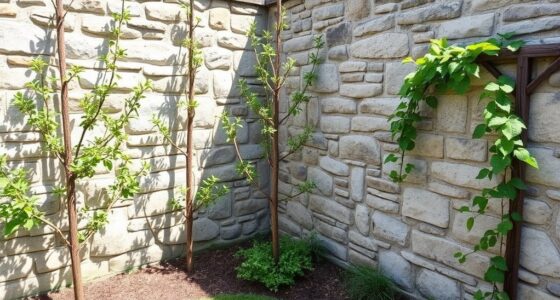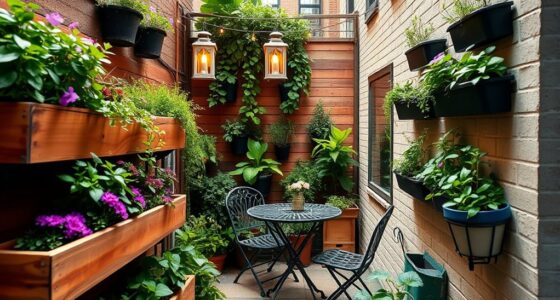For your low-light glass garden, choose plants like pothos, snake plants, and ferns that thrive in shaded areas and need minimal care. Incorporate mosses and creeping figs to add texture and softness, while drought-tolerant varieties keep watering easy. Focus on creating a lush, healthy display by maintaining proper humidity and airflow. Want to discover more inspiring plant ideas and care tips? Keep exploring to turn your glass garden into a stunning greenery oasis.
Key Takeaways
- Choose drought-tolerant plants like pothos, snake plants, and ZZ plants that thrive in low-light conditions.
- Incorporate mosses and ferns for added texture, moisture retention, and visual interest.
- Use layered plant heights and varying textures to create depth in glass gardens.
- Opt for air-purifying, low-maintenance plants to ensure longevity and healthy indoor air quality.
- Maintain high humidity and indirect light, and prune regularly to keep plants vibrant and healthy.
Top Low-Light Plants for Your Glass Garden

Are you looking to create a stunning glass garden in a space with limited natural light? Choosing the right plants is key. Low-light plants not only thrive in dim environments but also help with air purification, making your space healthier. Consider drought-tolerant varieties like pothos or snake plants—they require minimal watering and are resilient, perfect for busy or forgetful gardeners. These plants adapt well to shaded areas and add lush greenery without overwhelming the space. Their air-purifying qualities help remove toxins from the air, enhancing your indoor environment. Additionally, selecting plants that are easy to care for ensures your glass garden remains vibrant, low-maintenance, and beautifully suited for spaces with limited sunlight. Incorporating air-purifying plants can further improve indoor air quality and promote a healthier living space.
Care Tips for Shaded Terrarium Plants

Once you’ve chosen low-light plants like pothos or snake plants for your glass garden, caring for them properly guarantees they stay healthy and vibrant. Keep humidity levels consistent since shaded terrarium plants thrive in moist environments. Regularly mist the glass or use a humidity control device to prevent the air from becoming too dry. For moss propagation, gently trim any overgrown moss and encourage new growth by maintaining high humidity and indirect light. Additionally, avoiding overwatering is crucial; only water when the soil feels dry to the touch. Proper airflow helps prevent mold and rot. Regularly check your plants for pests or signs of stress, and prune as needed to promote healthy growth. Monitoring air quality and ensuring proper filtration can also contribute to a healthier environment for your plants. Incorporating automation technology such as humidity sensors can help maintain optimal conditions effortlessly. Maintaining appropriate ventilation is essential to prevent mold growth and ensure your plants thrive in a healthy environment. Consistent care ensures your shaded terrarium remains lush and thriving.
Creative Design Ideas Using Low-Light Greenery

Low-light greenery offers versatile options for creating stunning terrarium designs that require minimal sunlight. You can craft lush, textured scenes by combining plants like ferns, creeping fig, and mosses that thrive in humid environments. Use moss accents to add softness and visual interest, creating natural carpet-like layers or decorative patches. Incorporate different heights and textures to add depth, such as taller plants in the back and compact mosses in the foreground. These elements work well in glass gardens, especially in shaded spaces or areas with limited direct light. Additionally, selecting plants with low-light tolerance ensures your glass gardens remain vibrant and healthy over time. By blending low-light plants with moss accents, you’ll achieve a vibrant, cohesive look that’s both low-maintenance and visually appealing, perfect for bringing a touch of nature indoors. Incorporating plants that are drought-resistant can also help maintain your terrarium’s appearance with less frequent watering. Understanding plant care requirements helps you choose the right varieties that will thrive together in your glass garden environment.
Frequently Asked Questions
How Often Should I Water Low-Light Terrarium Plants?
For your low-light terrarium plants, you should establish a watering schedule based on soil moisture. Typically, check the soil every week, and only water when the top inch feels dry. Overwatering can cause root rot, so make certain the soil isn’t soggy. Adjust the frequency if you notice excess moisture or dryness. Remember, maintaining proper soil moisture keeps your plants healthy and thriving in their low-light environment.
Can I Add Colorful Flowers to My Low-Light Glass Garden?
Did you know that only about 10% of flowering plants thrive in low-light conditions? You can add colorful blooms to your glass garden, but choose flower varieties like begonias or violets that tolerate shade well. While vibrant flowers enhance visual appeal, keep in mind they may require extra care. Incorporate these colorful blooms carefully, ensuring they don’t overshadow your low-light plants and maintain the overall harmony of your glass garden.
What Are Common Pests for Shaded Terrarium Plants?
You should watch out for common pests like aphids, mealybugs, and fungus gnats that can attack shaded terrarium plants. To prevent pests, practice regular pest prevention by inspecting plants frequently and removing infested leaves. Use natural deterrents such as neem oil or insecticidal soap to keep pests at bay without harming your plants. Staying vigilant helps keep your low-light glass garden healthy and pest-free.
How Do I Prevent Mold in My Low-Light Terrarium?
Imagine your low-light terrarium suddenly developing mold—what do you do? You can prevent it by implementing effective mold prevention techniques and managing terrarium airflow. Guarantee proper ventilation by opening vents or slightly lifting the lid regularly, and avoid overwatering, which creates excess humidity. Keep the environment clean and remove any decayed plant matter promptly. These simple steps help maintain a healthy, mold-free terrarium, giving your plants the perfect environment to thrive.
Are There Low-Maintenance Plants Suitable for Beginners?
You’re wondering if there are easy care plants perfect for beginners. The good news is, many beginner friendly greenery thrive in low-light conditions and require minimal maintenance. Look for plants like pothos, snake plants, or ZZ plants—they’re resilient, forgiving, and adapt well to low light. These easy care plants make great starter choices, giving you a stress-free way to enjoy your terrarium without worrying about complex care routines.
Conclusion
With these low-light plants, your glass garden will transform into a lush, jungle-like paradise so vibrant, even the sun will envy your shady sanctuary. Imagine turning a tiny corner into a verdant wonderland that practically breathes life and magic into your space—no bright sunlight needed! So go ahead, get creative, and let your glass garden become the coolest, most mesmerizing green oasis that’ll make everyone say, “Wow, I wish I had that!”









